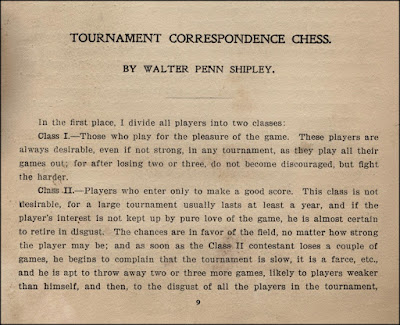Hints on Correspondence Chess Play, also, A History of the Association, its Objects, etc., published by the Pillsbury National Correspondence Chess Association, Chicago 1905.
The Pillsbury National Correspondence Chess Association was formed in January 1896 and was named in honour of H. N. Pillsbury, the recent winner of the Hastings Chess Tournament, 1895. The main aim was to provide chess competition for the many players nationwide who were unable to visit chess clubs which were usually only found in major cities.
This 12 page pamphlet is not recorded in Betts' Bibliography and the only copy that I can trace is held by the Cleveland Public Library, whose copy is also dated 1905, although this had already been published by 1897 according to an article about the Pillsbury National Correspondence Chess Association on pages 89-90 of American Chess Magazine for July 1897.
The pamphlet mentions the issue of Bulletins containing annotated games from the many tournaments that it organised but I can find no trace of these.
Following a brief history of the Association there are two articles giving general advice on correspondence chess play.
The first article is by Rev. Leander Turney who recommends the following books on the openings:
The first article is by Rev. Leander Turney who recommends the following books on the openings:
The German Handbuch - "The best book on the openings"
Chess Openings Ancient and Modern by Freeborough and Ranken - "best and most complete", in English.
Cook's Synopsis
The Modern Chess Instructor, Part I, by W. Steinitz - "one of the best works on the openings treated"
The second article is by Walter Penn Shipley who gives advice based on his own experiences of correspondence play, and recommends the following books:
The German Handbuch - "the most accurate of all the books on the openings"
The Modern Chess Instructor, Part I, by W. Steinitz
Chess Openings Ancient and Modern by Freeborough and Ranken
Shipley also refers to J. H. Bauer's Schach-Lexikon, first published in Vienna in 1899, describing this as "a very small book which gives the first ten moves of 2,000 games, and where they can be found".
As can be seen, my copy of this pamphlet is in poor condition; it is heavily marked and soiled, and the brittle paper is quite fragile.
© Michael Clapham 2017






No comments:
Post a Comment